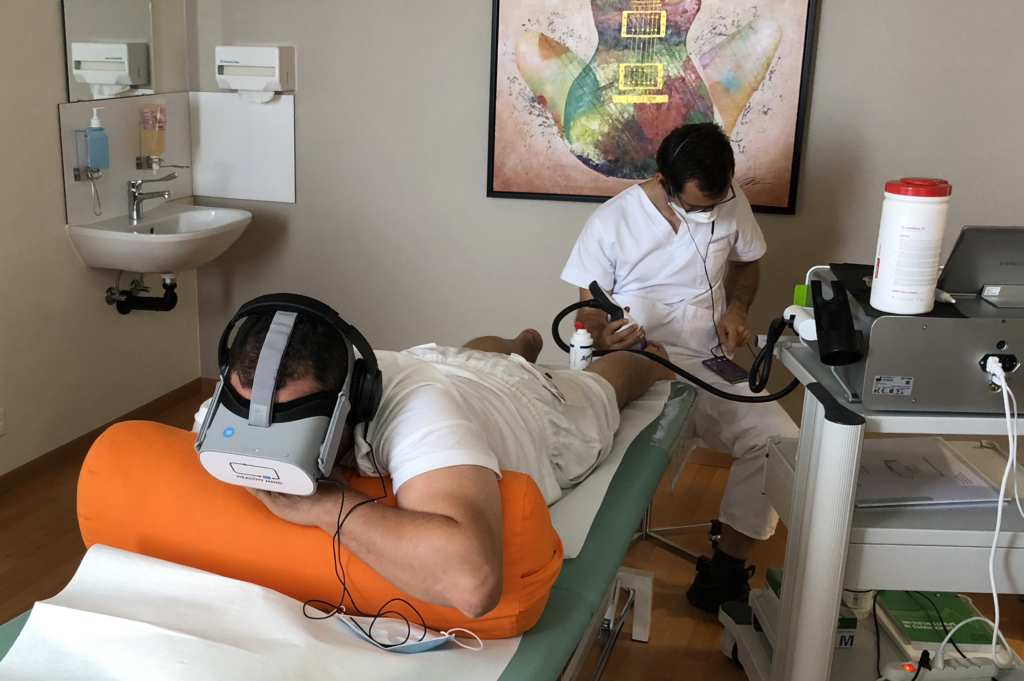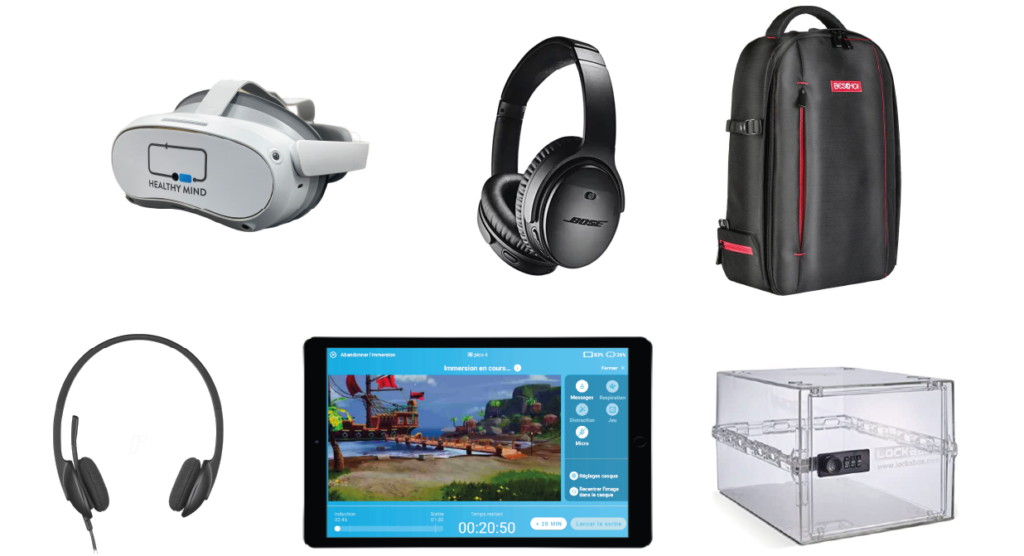Virtual reality therapy (VRT) is an innovative and effective method for improving patient care across various contexts: pre-operative anxiety, chronic pain, post-operative rehabilitation, and much more. Today, this technology, with its anxiolytic and analgesic properties, is emerging as a powerful therapeutic tool, complementing traditional care methods. How exactly does it work? What conditions and audiences can benefit from this personalised approach? Immerse yourself in the workings of therapeutic virtual reality and discover its full potential!
How does virtual reality exposure therapy work?
Virtual reality exposure therapy falls within the realm of cognitive behavioural therapy (CBT). In this sense, it develops a way of dealing with a person’s psychological distress based on an experimental methodology.
The patient is placed in a controlled and secure environment while exploring fictional three-dimensional scenarios. The VR headset projects realistic images and captivating sounds to create sensations that fully engage the senses. Using virtual reality software, the immersion artificially reproduces a sensory experience.
Far from being purely recreational, therapeutic virtual reality brings comfort, calm and relief to users, as this palliative care patient explains:
“I felt like I was floating on a cloud, surrounded by a fabulous, magnificent setting, teleported, transported. I forgot everything, forgot my illness, forgot my condition. It was pure bliss!”
As the scenery reveals its features, the patient’s attention is drawn away from a negative sensation, whether pain or anxiety, to focus on another perception. This process of attentional distraction brings profound relief and lasting effects for the well-being of users, without the need for medication.
Who can benefit from virtual reality therapy?
Virtual reality therapy does not exclude any particular age group; on the contrary, it is inclusive and cross-generational. Children, teenagers, adults and the elderly all benefit equally from the immersive experience.
Younger patients often enjoy the entertaining aspect and the inventive use of new technologies. Later generations appreciate the engaging process that arouses curiosity and stimulate the imagination.
In practice, healthcare professionals report largely positive feedback from patients:
“The innovative approach was well-received, as it sparked interest as well as curiosity. Its use instilled confidence in patients seeking non-medicinal ways of managing their pain.” Chrystelle Hautecoeur, nurse at the Eure-Seine hospital centre.
Does virtual reality therapy work for all pathologies?

Virtual reality therapy covers a wide range of applications. Thanks to its powerful anxiolytic and analgesic effects, immersions are an invitation to relax and soothe within procedures that are as complex as they are multifaceted. In this context, all patients suffering from pain or stress benefit from improved well-being after a session.
Among the most widespread use cases, therapeutic virtual reality works wonders for :
- anaesthesia and intensive care;
- paediatrics;
- oncology;
- palliative care;
- EHPAD;
- chronic pain;
- quality of life in the workplace.
The contraindications to virtual reality include cyberkinetosis and epilepsy. While the use of virtual reality for epilepsy is indeed restricted, the risk of virtual motion sickness is eliminated by the teleportation process developed in Healthy Mind’s immersive experiences.
Why choose virtual reality therapy rather than conventional treatment?
1. A treatment accessible to all generations
Virtual reality offers a device that demystifies therapy, attracting patients who might otherwise hesitate to seek care. Immersions bring a touch of lightness to an often anxiety-provoking hospital environment. Patients can escape repetitive thoughts and fears as their senses override mental distractions.
Without realising it, patients embrace the experience because it requires little investment on their part : all they have to do is put on a headset and headphones and they’re carried away. The promise of virtual reality also meets the expectations of people looking for a non-medicinal solution to anxiety and pain.
2. A blend of techniques to promote immersion
The immersion provided by Healthy Mind virtual reality headsets combines a number of therapeutic principles to enhance the sensation of well-being:
- high graphic quality 3D environments;
- unique hypnotic scripts tailored to the chosen simulation;
- breathing exercises to achieve cardiac coherence;
- immersive soundscapes inspired by the benefits of music therapy.
All our environments are developed under the supervision of a rigorous scientific committee. Every detail is carefully designed to alleviate discomfort. Furthermore, we are committed to supporting and enriching clinical studies about virtual reality, a process that holds so much promise for healthcare. To find out more about our contribution, take a look at the published and ongoing studies in which we are involved.
3. A fully customisable experience
The Healthy Mind Control tablet gives you an intuitive interface for setting up, monitoring and controlling your immersions. A host of features ensure seamless integration into your medical workflow:
- creation of a user profile for each use case;
- secure connection between the headset and the tablet, without requiring internet access;
- customisation of hypnosis via microphone;
- ongoing communication with the patient;
- adjustable session durations from 5 to 80 minutes;
- 13 languages available.
You can see how easy it is to use our solution in this report from the oncology department at Yverdon.

4. An autonomous device that frees up healthcare professionals
Athough a tool cannot replace the intervention of carers, it does help to lighten their workload. Training medical staff in relaxation techniques such as therapeutic hypnosis requires time and money, two resources often in short supply.
Virtual reality headsets offer an affordable alternative for patients to benefit from therapy, without the need to involve nurses or tedious training. What’s more, the system’s versatility and user-friendly design ensure smooth integration into care pathways.
A study has also shown the benefits of home self-administered virtual reality in the treatment of chronic low back pain. At the end of an 8-week period, the average intensity of pain and pain-related interference with activity, mood and stress were significantly reduced. These results highlight the therapeutic potential of virtual reality for monitoring patients outside the hospital setting.
5. A tool for a therapeutic alliance: the example of Agissons Ensemble
Traditional therapy relies on the patient’s imagination to project ideas, landscapes and sensations. However, we aren’t all equal in our ability to perceive this immaterial horizon. Virtual reality therapy doesn’t just give suggestions, it offers an immersive experience that creates the illusion of presence.
Nancy Christ, wellbeing project coach at Agissons Ensemble, talks about this unique facet in an interview about the combination of coaching and virtual reality :
“The wonderful thing about the Healthy Mind solution is that we’ve been able to add a new string to our bow. We can offer relaxation sessions in different ways: with headsets, without headsets or combining the two approaches. We’ve found that using the headphones allows us to go faster and further. With the headsets on, people are quickly immersed and they let go more quickly too.”
What equipment is needed for virtual reality therapy?

Therapeutic VR systems offers a compact, easily transportable device that can be adapted to any situation:
- a 4K virtual reality headset;
- Bose audio headphones;
- a storage bag;
- a microphone to personalise hypnotic speeches;
- a tablet;
- a secure storage box.
To support your successful deployment of VR therapy, you can choose between renting or buying our solution.
Virtual reality therapy represents a modern, innovative and recognised approach to relieving anxiety and pain. Mobile, versatile and inventive, it transports patients of all ages in a world where the marvellous meets the everyday. The equipment is easy to store and deploy, optimising both your time and the patient’s experience. If you too would like to discover Healthy Mind environments and try out our device, we would be delighted to organise a demonstration.







